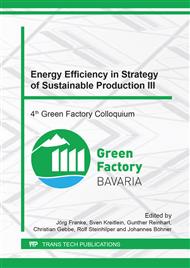p.3
p.11
p.20
p.27
p.36
p.44
p.52
p.60
Time-Discrete Modelling of Industrial Compressed Air Systems Based on Equivalent Circuits
Abstract:
Compressed air systems (CAS) on industrial plants consist of air compressors, compressed air reservoirs, compressed air lines and auxillaries as dehumidifiers, dust collectors, pneumatic oilers and pressure controllers. It is assumed that given suitable dimensioning, those industrial compressed-air systems can be used for demand side management purpose. In industrial CAS energy is transmitted by means of pressure difference and volumetric flow rate of the transmission medium compressed air. Alike electric circuits, they consist of various functional components which are flowed through by the compressed air. Furthermore the application of Kirchhoffs laws is possible to those systems. Hence, approximation of the behavior of industrial CAS is possible by arranging and connecting those components in an equivalent circuit diagram. As additional state variables of compressed air as humidity, temperature as well as contents of water, oil and dust are also to be considered, modeling of the individual components is more extensive. A general, abstract approach for the description of the individual components in the form of blackbox representations is outlined.
Info:
Periodical:
Pages:
20-26
Citation:
Online since:
October 2017
Authors:
Keywords:
Price:
Сopyright:
© 2017 Trans Tech Publications Ltd. All Rights Reserved
Share:
Citation:


